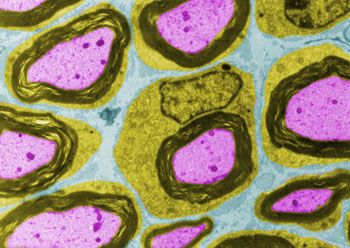Damaged Nerve Regeneration Depends on Epigenetic Regulation of Cell Genes
By LabMedica International staff writers
Posted on 29 Sep 2016
A team of neuroscientists has identified a key epigenetic step that enables Schwann cells to initiate regeneration of damaged axons in the peripheral nervous system (PNS).Posted on 29 Sep 2016
Schwann cells are known for their roles in supporting nerve regeneration. If damage occurs to a nerve, the Schwann cells will aid in digestion of its axons (phagocytosis). Following this process, the Schwann cells can guide regeneration by forming a type of tunnel that leads toward the target neurons. The stump of the damaged axon is able to sprout, and those sprouts that grow through the Schwann cell “tunnel” do so at the rate of approximately one millimeter per day in good conditions. The rate of regeneration decreases with time. Successful axons can therefore reconnect with the muscles or organs they previously controlled with the help of Schwann cells, however, specificity is not maintained and errors are frequent, especially when long distances are involved. If Schwann cells are prevented from associating with axons, the axons die. Regenerating axons will not reach any target unless Schwann cells are there to support them and guide them.

Image: Supportive Schwann cells (green) surround the conductive axon (purple) of a neuron in the peripheral nervous system in this artificially colored image. Schwann cells not only make the insulating myelin (black), but also are active players in axon repair after damage (Photo courtesy of Dr. John Svaren, University of Wisconsin).
Investigators at the University of Wisconsin (Madison, USA) reported in the August 31, 2016, issue of the Journal of Neuroscience that peripheral nerve regeneration after injury was dependent upon implementation of a novel genetic program in Schwann cells that supported axonal survival and regeneration. In this novel epigenomic pathway the reversal of the Polycomb pathway of repressive histone methylation was required for activation of a significant number of injury-induced genes. The Polycomb Repressive Complex 2 (PRC2) is known to catalyze the trimethylation of lysine 27 of histone H3 (H3K27me3), which produces a transcriptionally repressive chromatin environment.
"Almost every other nervous-system injury response, especially in the brain, is thought to require stem cells to repopulate the cells, but there are no stem cells here," said senior author Dr. John Svaren, professor of comparative biosciences at the University of Wisconsin. "The Schwann cells are reprogramming themselves to set up the injury-repair program. We are starting to see them as active players with dual roles in protecting and regenerating the axon, and we are exploring which factors determine the initiation and efficacy of the injury program. We have thought of the Schwann cell as a static entity that was just there to make myelin, but they have this latent program, where they become the first responders and initiate many actions that are required for the axon to regenerate."
Related Links:
University of Wisconsin









 Analyzer.jpg)




